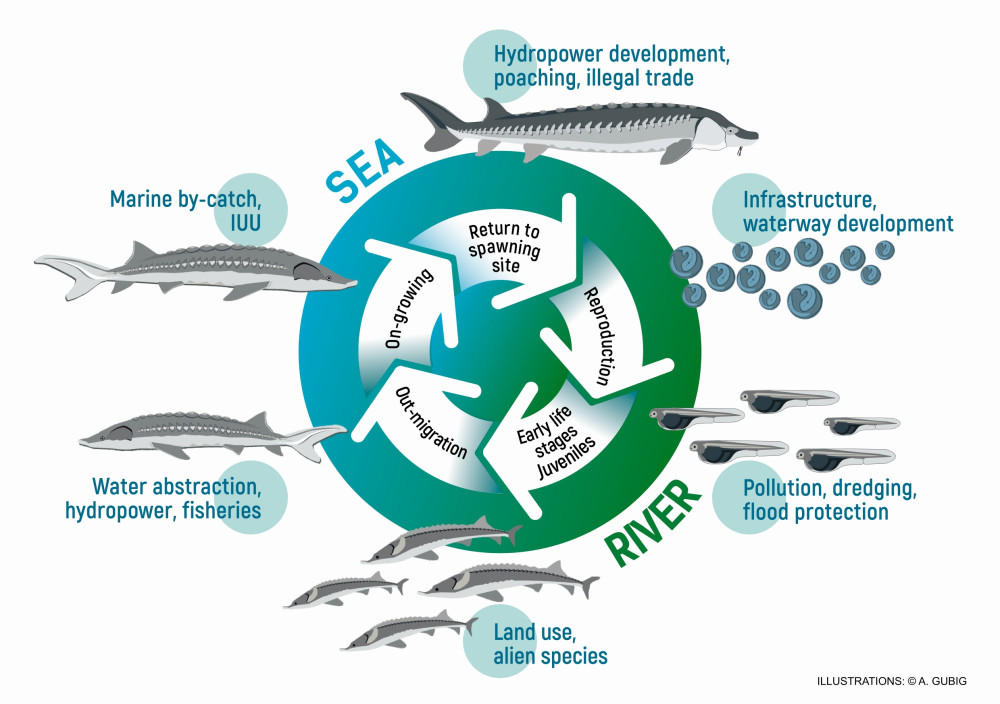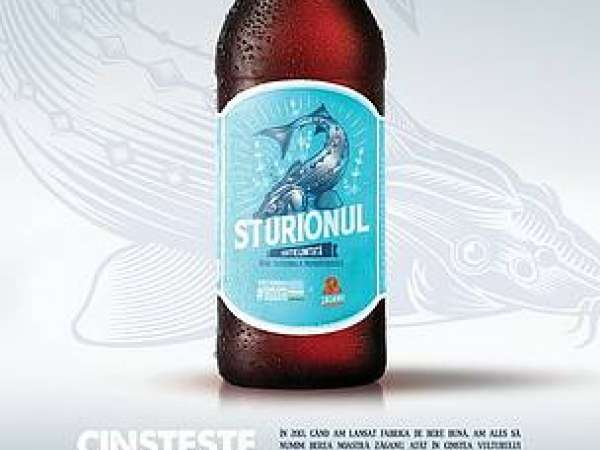THE FIGHT FOR THE GIANTS OF THE DANUBE
 |
| Generalised life cycle of sturgeon and the main threats impacting the various life stages |
Not long ago, magnificent, 5-meter long beluga sturgeons migrated up the Danube as far as Germany and provided livelihoods for numerous fishing communities. No longer. The disruption of migration routes and the overfishing fueled by high economic gains for the luxury product of sturgeon, led to a collapse of sturgeon populations. In the Danube, historically six species existed. Yet two are believed to be extinct already and of the remaining four species three are critically endangered, IUCN’s highest threat category before extinction. Find out more about the species on the website of the Danube Sturgeon Task Force (DSTF) which works in close partnership with WWF.
Globally, the situation is not better. Human pressure earned sturgeon an infamous world record: they represent the most endangered group of species on the IUCN Red List of Threatened Species, with few natural habitats left for them to call home.
The urgency for protection has been stated in many scientific and policy documents, yet implementation of conservation measures is slow and WWF voices out clear calls to action.
| Sturgeon Factsheet 2023 |
Illegal Fishing & Trade
All Black Sea and Lower Danube countries have legally banned fishing of sturgeon, yet illegal activities including the use of illegal fishing gear, the poaching and consecutive selling of sturgeon remain a high threat in the region. WWF regularly compiles data available from authorities across Bulgaria, Romania and Ukraine that documents all forms of sturgeon trafficking. This data report is the only one of its kind examining the regional problem of sturgeon populations that migrate between these countries. Find here the link to our recent report with 337 cases of illegal activities involving sturgeon recorded between 2016 and 2022.
Applying forensic analytic methods, WWF’s market survey (2021) had additionally revealed that one third of the sturgeon meat and caviar products in Bulgaria, Romania, Serbia and Ukraine were sold illegally. Specifically, 19% of all samples came from wild sturgeon, which cannot currently be legally caught or traded anywhere in the region, while another 12% did not comply with international trade regulations.
As many cases do remain undetected and reported, these numbers only reveal the tip of the iceberg of hidden illegalities, WWF calls on authorities to remain committed to the fight against this wildlife crime and has developed various reports and training material to support this fight. Find out more on www.danube-sturgeons.org.
WWF's efforts to curb this illegal activity include developing innovative approaches to aid enforcement authorities, who struggle with sufficient resources or capacity. In Romania, successful methods include using camera traps, or testing drone surveillance over the vast area of the Romanian Danube Delta. In Bulgaria, WWF collaborated with the Bulgarian border police to successfully utilise underwater sonar equipment to detect illegal hook lines (karamci).
By-Catch
Little is known on the numbers of sturgeon that land as by-catch in the nets of fishermen. Legally, all caught sturgeon must be released back to the water, dead or alive and only recently an obligation to report sturgeon by-catch was introduced, but so far no official reports exist.
Single fishermen also concerned about the decline of sturgeon have engaged in sturgeon conservation and demonstrated best-practice by releasing accidentally caught sturgeon.
Habitat Loss
The construction of dams in the main stem of the Danube has led to a blockage of their migration route. Yet 800km of free flowing river stretch in the Lower Danube connects the Black Sea to their last spawning and feeding grounds. These key habitats must be protected against further degradation caused by dredging activities, navigation constructions or other infrastructure buildings.
Understanding where these habitats are and monitoring fish are a critical prerequisite for any meaningful protection measures. More information can be found here.
Breeding & Release
Unfortunately, sturgeon stocks have been depleted to an extent where self-recovery needs to be supported by breeding and release programmes. This is a last resort conservation measure and must be done based on scientific guidance and in a coherent manner in the whole river basin.
Supported by WWF, the World Sturgeon Conservation Society (WSCS) and the DSTF developed recommendations for the establishment of conservation hatcheries and conservation stocking that explain what needs to be taken into account in this difficult undertaking.
Within the EU project LIFE-Boat 4 Sturgeon, its international partners pursue the goal of saving the remaining four sturgeon species in the Danube from extinction. From 2022 to 2030, the project partners will be implementing six conservation measures to rescue the species Russian sturgeon, sterlet, stellate sturgeon and beluga sturgeon. Read more here ...
Engagement of Fishermen
Fishermen have been part of the problem and must now become part of the solution to conserve sturgeon, and many of them are also concerned about their decline. For decades fishing communities have thrived on sturgeon fisheries and the trade of their products and after fishing was banned they have been left with no alternatives for income generation.
There is a need to support these communities in creating a sustainable future, with alternative income streams and by engaging them actively in conservation actions, such as sturgeon monitoring. The recovery of sturgeon populations to an extent where sustainable fishing may be feasible again will be an undertaking of decades rather than years.
Regional Cooperation & Political Support
But saving sturgeon from extinction is a complex undertaking and can only be achieved through cross-sectoral and cross-border cooperation, and a strong political will. Sectors and institutions needed to cooperate towards sturgeon conservation include fishery authorities responsible for enforcing fishing bans, Ministries for Environment responsible for monitoring and overall conservation plans and Ministries for Water and Sea Areas responsible for securing the habitats as well as the navigation and dredging sector which can either threaten or spare these habitats.
What is also needed is the cooperation of scientific institutions to share and exchange information such as monitoring data. WWF and the DSTF play a key role in convening different actors.
In an international River Basin such as the Danube where action or non-action of one country has effect on shared stocks, cooperation across borders and coherence of conservation actions are key to success. The International Commission for the Protection of the Danube River (ICPDR) has thus endorsed sturgeons as flagship species.
WWF urges Danube region Governments to implement the PanEuropean Action Plan for Sturgeons (PANEUAP) adopted by 50 states (including all Danube countries) under the Bern Convention in November 2018 and endorsed fom implementation under the EU Habitats Directive in 2019. The Plan provides a framework for national and regional action and calls for swift adoption of concrete measures, including making hydropower dams passable for sturgeons, reducing by-catch, establishing breeding facilities, habitat protection and restoration, and combating illegal trade in sturgeon products.
Adequate funding instruments must be put in place for long term conservation actions. This includes a funding plan outlining national and international, private and government funding options, and a strategy for national programming of EU funds to supply part of these resources.
More information on sturgeon globally on the WWF sturgeon initiative website.





























